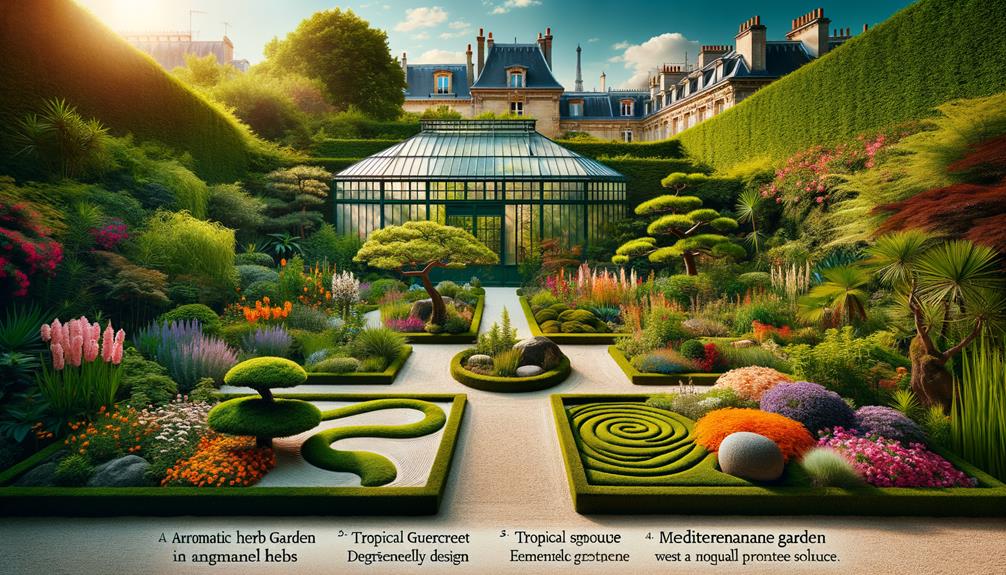Stepping into the Padua Botanical Garden felt like entering a timeless sanctuary. The scent of ancient medicinal plants mingled with the aroma of exotic species from faraway lands. Our guide shared stories of early botanists and their groundbreaking research, and I was immediately drawn in by the rich history of the place. Each corner of the garden seemed to have a hidden story, and it was clear that this tour was only the beginning. What really caught my eye, though, was…
History and Significance
Founded in 1545, the Padua Botanical Garden is a testament to centuries of botanical research and cultural heritage. As I walked through its historic paths, I felt the profound weight of its significance. The garden, a UNESCO World Heritage site, exemplifies human curiosity and our ongoing quest to understand nature.
Passing by beds of medicinal plants, I was reminded of how these simple herbs once formed the core of early medicine. Monks and scholars meticulously catalogued these plants, eager to learn their secrets and harness their healing powers. The garden's layout itself is telling, designed to encourage both reflection and study.
It's intriguing to think about the many botanists who have walked these paths before me, each adding to a legacy of knowledge. The Padua Botanical Garden is more than just a collection of plants; it's a living museum that has significantly shaped our understanding of botany. Here, history is alive in every leaf and petal, inviting visitors to pause and reflect on the deep connections between nature, science, and culture. It's a place where the past and present coexist in harmony, offering a unique glimpse into our botanical heritage.
Notable Plants

Strolling through the Padua Botanical Garden, I was captivated by the ancient medicinal plants like Ginkgo biloba, with its golden leaves shining in the autumn sun. Among the rare exotic flora, the towering Magnolia grandiflora caught my eye with its massive, fragrant white flowers. Seasonal highlights, like the olive trees filled with fruit, painted a vivid picture of the garden's diverse and culturally rich botanical collection.
Ancient Medicinal Species
As I walk through the Padua Botanical Garden, I'm struck by the ancient medicinal plants that reveal tales of old remedies and cultural traditions. The OrtoBotanico di Padova, with its extensive plant collection, offers a unique window into the historical uses of plants for healing.
The first plant I come across is the Magnolia grandiflora L., Italy's oldest specimen, planted in 1786. Its impressive height and large, shiny leaves highlight its long-standing presence in the garden. Nearby, I find the Olea europaea, a symbol of Mediterranean culture, known for its valuable fruits and oil used in cooking and medicine. The strong wood from this tree has been used in carpentry for many years.
| Plant Species | Notable Uses |
|---|---|
| Magnolia grandiflora L. | Ornamental, symbolic in Italy |
| Olea europaea | Olive oil, fruit consumption, woodworking |
| Prunus dulcis | Food, medicine, cosmetics |
Further along, I spot the Phoenix dactylifera, with its slender trunk reaching up to 30 meters. This palm, known for its edible dates, has been cultivated for thousands of years. Nearby, the native Artemisia nitida grows on sunny rocks and high elevations, valued in traditional medicine for its aromatic properties. Each plant here holds stories of ancient wisdom, deeply embedded in the heritage of the OrtoBotanico di Padova.
Rare Exotic Flora
The Padua Botanical Garden's collection of rare plants always amazes me with its variety and the stories each plant carries from its homeland. As I wander through the OrtoBotanico di Padova, my attention is immediately grabbed by the Magnolia grandiflora L., which can grow up to 30 meters tall and boasts large, fragrant white flowers. This impressive tree, native to the southeastern United States, brings a touch of a distant place.
Another highlight is the Phoenix dactylifera, known as the date palm. This tree, often reaching 30 meters in height, is famous for its sweet, edible fruits and holds deep cultural significance in many Middle Eastern societies. Seeing it here reminds me of its role in ancient trade routes and culinary traditions.
Then there's the Ginkgo biloba, a tree that has existed for millions of years and features fan-shaped leaves. In the autumn, its leaves turn a striking golden yellow, adding a vibrant splash of color to the garden. Its unique appearance and ancient history make it a captivating plant to study.
- Magnolia grandiflora L.: Tall with fragrant white flowers
- Phoenix dactylifera: Slender trunk, produces edible fruits
- Ginkgo biloba: Fan-shaped leaves, turns golden in autumn
Each plant in the Padua Botanical Garden connects us to different parts of the world, deepening our appreciation for botanical diversity.
Seasonal Highlights Display
Wandering through the Seasonal Highlights Display, I'm struck by the variety among the 3,500 plant species on show. Each one has adapted to the changing seasons, adding bursts of color and life to the garden. The Magnolia grandiflora L. is particularly impressive, standing as tall as 30 meters. Its large, dark green leaves and huge white flowers, which can span 20-25 centimeters, are simply stunning.
Close by, the olive tree, known as Olea europaea, draws my attention. Beyond its olives, its yellow-brown wood is highly valued for woodworking, showcasing a connection between nature and human craftsmanship. The almond tree, or Prunus dulcis, offers a treat for both taste and beauty. Its sweet and bitter almonds are key ingredients in both confectionery and cosmetics.
The date palm, Phoenix dactylifera, stands out with its slender trunk reaching up to 30 meters. Known for its sweet, edible fruits, it reflects the rich agricultural traditions of the OrtoBotanico di Padova. Each plant here tells a story of survival and adaptation, inviting us to appreciate the endless wonders of nature.
Themed Sections

As I stroll through the Padua Botanical Garden, it's amazing to see how each section offers a unique window into different ecosystems and historical plant collections. The Orto botanico, known as the world's oldest academic garden, feels like a living museum, brimming with opportunities for learning and wonder.
One of my favorite spots is the Mediterranean Garden. The scent of aromatic herbs and the sight of ancient olive trees instantly transport me to sunlit coastlines. Just a short walk away, the Water Garden features a variety of aquatic plants, their delicate leaves floating peacefully on the water. It's a calming retreat that invites quiet reflection.
The Garden of Biodiversity is another highlight, showcasing an impressive array of plants from various climates and continents. Within moments, you can wander through a vibrant tropical rainforest, take in the stark beauty of a desert, and appreciate the hardy plants of alpine regions. Each section celebrates the incredible diversity of the plant world.
- Mediterranean Garden: Filled with aromatic herbs and ancient olive trees.
- Water Garden: Hosts a variety of aquatic plants and tranquil water features.
- Garden of Biodiversity: Displays plants from different climates and continents.
Walking through these sections feels like a global botanical journey, all within the garden's walls.
Guided Tours

Joining a guided tour at the Padua Botanical Garden is a truly enriching experience. It's a perfect blend of expert knowledge and fascinating stories about the garden's history and its diverse plant collections. As I walked through the Old Garden, the guide's narrative transported me to the 16th century when the University of Padua first created this green sanctuary in 1545. The stories of early botanists and their groundbreaking work added so much depth to every plant and tree we encountered.
Our guide highlighted the unique aspects of the Old Garden, pointing out medicinal plants that once served as natural remedies for scholars. Each section of the garden showcased botanical wonders that have been carefully maintained over the centuries. The guide's enthusiasm was contagious, making me appreciate the garden as a living record of botanical history.
Walking along the lush paths, I was amazed at how the guided tours seamlessly connect the garden's past with its present. Hearing anecdotes about rare species and their origins gave me a sense of global interconnectedness. The tour was more than just informative; it was a cultural journey that deepened my appreciation for the blend of nature and academia. It's an experience that will resonate with anyone who values the spirit of exploration and discovery.
Visitor Information

After the guided tour, I was pleased to learn about the various amenities the Padua Botanical Garden offers to make your visit enjoyable and educational. The garden is thoughtfully designed for both comfort and accessibility.
One of the first things that caught my eye were the well-marked paths, which make it easy to explore the different sections. Each area is filled with unique plants and occasional sightings of squirrels and birds. Informative signs are scattered throughout, providing interesting details about the plant species and their ecological roles.
The visitor center stood out to me as a bustling hub of activity and resources. Here, you can pick up maps and brochures, or take a break at the cozy café to soak in the garden's tranquility. Additionally, the garden offers:
- Restrooms: Conveniently located and clean.
- Gift Shop: A great place to find botanical books and unique souvenirs.
- Benches and Picnic Areas: Perfect for sitting, reflecting, and enjoying the natural surroundings.
The Padua Botanical Garden truly excels at creating a welcoming and enriching experience for all who visit.
Tips for Your Visit

When I visited the Padua Botanical Garden, I quickly saw how crucial timing and preparation were. Early mornings are perfect for skipping the crowds and soaking in the garden's peaceful beauty. Make sure to bring comfortable shoes and a hat, and think about joining a guided tour to learn more about this historic spot.
Best Visiting Times
If you're looking for the best time to visit the Padua Botanical Garden, spring is a great choice. The garden comes alive with vibrant blooms, and the air is filled with the sweet scent of flowers, creating a magical atmosphere. Plus, the longer daylight hours mean you can enjoy even more of this beautiful space.
That said, the garden is charming year-round. The greenhouses, filled with tropical plants, offer a warm and peaceful retreat no matter the weather. Here are a few tips to help you make the most of your visit:
- Check the opening hours: The garden has shorter hours on Sundays, so it's a good idea to check ahead, especially on busy days like Palm Sunday.
- Plan for a half-day visit: To really soak in the garden's beauty and history, set aside at least half a day.
- Self-guided tours: While guided tours are available, you can also explore at your own pace using maps or audio guides.
With a bit of planning, your visit to the Padua Botanical Garden will be both enjoyable and memorable.
Essential Items Checklist
Getting ready for your visit to the Padua Botanical Garden? Here are a few things you'll want to bring along to make the most of your trip.
First off, comfy walking shoes are a must. The garden is huge with lots of paths and different terrains, so you'll want to explore it all on foot. A lightweight backpack is handy for carrying water, snacks, and a map, leaving your hands free for snapping photos.
Speaking of photos, don't forget your camera or smartphone. The plants are stunning and perfect for photography. Sunscreen and a hat are also key, as the Italian sun can be pretty strong, especially in open areas. A small notebook and pen come in handy for jotting down plant names or any thoughts that come to mind as you wander.
Also, bring a reusable water bottle. Staying hydrated is crucial for keeping your energy up throughout the day. An umbrella or rain jacket is a good idea too, just in case the weather changes. With these items, you'll be all set to take in the beauty and history of the Padua Botanical Garden.
Guided Tours Benefits
Even though you might be all set with your essentials, taking a guided tour of the Padua Botanical Garden can really deepen your experience. Exploring on your own is enjoyable, but a guided tour lets you learn more about the garden's history, biodiversity, and cultural importance. I found that the guides, with their deep knowledge, made the garden come alive in ways I never expected.
Here are some of the benefits of guided tours:
- Detailed Information: Guides share interesting stories and facts about rare plants and historical landmarks you might overlook on your own.
- Interactive Experience: You can ask questions and have discussions, making the visit more engaging and tailored to your interests.
- Special Access: Some tours provide a behind-the-scenes look at areas usually closed to the public, adding a unique touch to your visit.
Walking through the lush pathways with a guide, I felt more connected to the garden's intricate details. Every plant and corner had a story to tell. This curated experience made my visit much more meaningful, turning it from a simple walk into a memorable journey. So, if you're looking for a deeper exploration, a guided tour is the way to go.
Frequently Asked Questions
What Is the Famous Botanical Garden in Italy?
When I strolled through Italy, I came across the renowned Orto Botanico in Padua. Established in 1545, it's the oldest academic garden in the world. The ancient plants and peaceful ambiance offered a refreshing break from everyday life.
How Long Does It Take to Walk Through Botanical Gardens in San Antonio?
I strolled through the San Antonio Botanical Garden and spent about 2-3 hours taking in everything they had to offer. The colorful displays and peaceful paths were so captivating that I lost track of time, enjoying the chance to wander freely.
What Is the World's First Arboretum?
It's funny you asked about the first arboretum. That would be the Chelsea Physic Garden in London, established back in 1673. I had the chance to walk through its historic grounds once, and it felt like stepping into a different time, surrounded by nature and history.
What Is the First Botanical Garden in Europe?
The first botanical garden in Europe is the Orto Botanico di Padova, established in 1545 in Italy. Walking through its historic grounds, I felt a profound connection to nature's timeless beauty and humanity's enduring quest for knowledge.



